A novel CaM kinase II pathway controls the location of neuropeptide release from Caenorhabditis elegans motor neurons
- PMID: 24653209
- PMCID: PMC3948804
- DOI: 10.1534/genetics.113.158568
A novel CaM kinase II pathway controls the location of neuropeptide release from Caenorhabditis elegans motor neurons
Abstract
Neurons release neuropeptides via the regulated exocytosis of dense core vesicles (DCVs) to evoke or modulate behaviors. We found that Caenorhabditis elegans motor neurons send most of their DCVs to axons, leaving very few in the cell somas. How neurons maintain this skewed distribution and the extent to which it can be altered to control DCV numbers in axons or to drive release from somas for different behavioral impacts is unknown. Using a forward genetic screen, we identified loss-of-function mutations in UNC-43 (CaM kinase II) that reduce axonal DCV levels by ∼90% and cell soma/dendrite DCV levels by ∼80%, leaving small synaptic vesicles largely unaffected. Blocking regulated secretion in unc-43 mutants restored near wild-type axonal levels of DCVs. Time-lapse video microscopy showed no role for CaM kinase II in the transport of DCVs from cell somas to axons. In vivo secretion assays revealed that much of the missing neuropeptide in unc-43 mutants is secreted via a regulated secretory pathway requiring UNC-31 (CAPS) and UNC-18 (nSec1). DCV cargo levels in unc-43 mutants are similarly low in cell somas and the axon initial segment, indicating that the secretion occurs prior to axonal transport. Genetic pathway analysis suggests that abnormal neuropeptide function contributes to the sluggish basal locomotion rate of unc-43 mutants. These results reveal a novel pathway controlling the location of DCV exocytosis and describe a major new function for CaM kinase II.
Keywords: C. elegans; CaM Kinase II; Dense core vesicle; Neuropeptide release; Regulated secretion; placeholder.
Figures
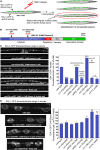

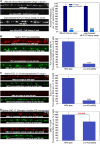



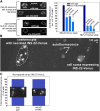
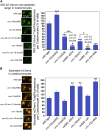
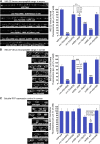
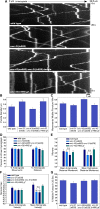


Comment in
-
Dense core vesicle release: controlling the where as well as the when.Genetics. 2014 Mar;196(3):601-4. doi: 10.1534/genetics.113.159905. Genetics. 2014. PMID: 24653208 Free PMC article.
Similar articles
-
Cyclin-dependent kinase 5 regulates the polarized trafficking of neuropeptide-containing dense-core vesicles in Caenorhabditis elegans motor neurons.J Neurosci. 2012 Jun 13;32(24):8158-72. doi: 10.1523/JNEUROSCI.0251-12.2012. J Neurosci. 2012. PMID: 22699897 Free PMC article.
-
Impaired dense core vesicle maturation in Caenorhabditis elegans mutants lacking Rab2.J Cell Biol. 2009 Sep 21;186(6):881-95. doi: 10.1083/jcb.200902095. J Cell Biol. 2009. PMID: 19797080 Free PMC article.
-
Tomosyn negatively regulates CAPS-dependent peptide release at Caenorhabditis elegans synapses.J Neurosci. 2007 Sep 19;27(38):10176-84. doi: 10.1523/JNEUROSCI.2339-07.2007. J Neurosci. 2007. PMID: 17881523 Free PMC article.
-
Dense core vesicle release: controlling the where as well as the when.Genetics. 2014 Mar;196(3):601-4. doi: 10.1534/genetics.113.159905. Genetics. 2014. PMID: 24653208 Free PMC article.
-
A network of G-protein signaling pathways control neuronal activity in C. elegans.Adv Genet. 2009;65:145-192. doi: 10.1016/S0065-2660(09)65004-5. Adv Genet. 2009. PMID: 19615533 Review.
Cited by
-
CaMKII mediates sexually dimorphic synaptic transmission at neuromuscular junctions in C. elegans.J Cell Biol. 2023 Nov 6;222(11):e202301117. doi: 10.1083/jcb.202301117. Epub 2023 Aug 25. J Cell Biol. 2023. PMID: 37624117 Free PMC article.
-
The neurohormone tyramine stimulates the secretion of an insulin-like peptide from the Caenorhabditis elegans intestine to modulate the systemic stress response.PLoS Biol. 2025 Jan 28;23(1):e3002997. doi: 10.1371/journal.pbio.3002997. eCollection 2025 Jan. PLoS Biol. 2025. PMID: 39874242 Free PMC article.
-
Synapsin Is Required for Dense Core Vesicle Capture and cAMP-Dependent Neuropeptide Release.J Neurosci. 2021 May 12;41(19):4187-4201. doi: 10.1523/JNEUROSCI.2631-20.2021. Epub 2021 Apr 5. J Neurosci. 2021. PMID: 33820857 Free PMC article.
-
UNC-16 (JIP3) Acts Through Synapse-Assembly Proteins to Inhibit the Active Transport of Cell Soma Organelles to Caenorhabditis elegans Motor Neuron Axons.Genetics. 2015 Sep;201(1):117-41. doi: 10.1534/genetics.115.177345. Genetics. 2015. PMID: 26354976 Free PMC article.
-
Cell non-autonomous signaling through the conserved C. elegans glycoprotein hormone receptor FSHR-1 regulates cholinergic neurotransmission.PLoS Genet. 2024 Nov 19;20(11):e1011461. doi: 10.1371/journal.pgen.1011461. eCollection 2024 Nov. PLoS Genet. 2024. PMID: 39561202 Free PMC article.
References
-
- Baylis H. A., Furuichi T., Yoshikawa F., Mikoshiba K., Sattelle D. B., 1999. Inositol 1,4,5-trisphosphate receptors are strongly expressed in the nervous system, pharynx, intestine, gonad and excretory cell of Caenorhabditis elegans and are encoded by a single gene (itr-1). J. Mol. Biol. 294: 467–476. - PubMed
-
- Borgonovo B., Ouwendijk J., Solimena M., 2006. Biogenesis of secretory granules. Curr. Opin. Cell Biol. 18: 365–370. - PubMed
Publication types
MeSH terms
Substances
Grants and funding
LinkOut - more resources
Full Text Sources
Other Literature Sources
Molecular Biology Databases
Miscellaneous

